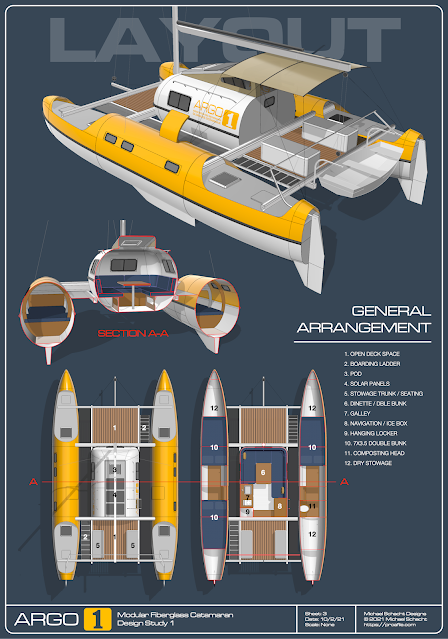Something I found especially depressing, a flat earth football team, and in the "Just spiraling down the ceramic throne" department...
Building a boat bigger than a dinghy is, generally speaking, a complex exercise. More importantly the bigger the boat the more complex it gets.
Now, if I wanted to build a dinghy (like the Bolger Nymph) it might have a dozen or so parts, use up a couple or three sheets of plywood, cost a bit less than $200 in materials, and take somewhere around sixteen hours of labor to complete.
Let's say you want to build a catamaran just over thirty feet in length that you could sail off into the sunset with...
That's going to be a little daunting for someone whose craft experience might be putting together an Ikea kitchen cabinet.
Which brings us to Michael Schacht's Argo...
Argo is a modular design that has me fairly excited as it's simple and quick to build which results in large savings in both time and money.
As the Argo is still a work in progress, I can't really get too deep into the how of building it but as far as building with a modular system I can point out a few things.
First of which is the bulk of the work is molding panels on a couple of molds and molds make a lot of sense where building boats in composite materials are concerned. In this case the molds are dead simple and can be built by your average tyro-level builder in a couple of days.
The construction of the boat requires one to make eighteen molded hull sections that are then assembled to make up the two hulls and bridgedeck pod. With a bow and body mold that means you could mold two sections a day which adds up to less than two weeks of labor.
Assembling the various pieces together would go fairly quickly and a couple of weeks would not be unheard of but, being a "the glass is half empty" kind of guy, why don't we say three weeks to which we add another month for the over all fit out...
Of course, to make this boat truly affordable (dare we say VolksCruiser?) we will also be building the rig and most of the needful hardware which will add another month to the mix but save a very large chunk of cash in the process.
So where do we stand so far?
Thirteen weeks or 520 hours of labor or 65 eight-hour days.
Kind of beats the 2000 hours of labor all to hell, does it not?
That said, all these projections assume the person or persons building the boat are capable of sustained, full-time productive labor and actually able to build the plan as drawn. Working part time on such a project will negate any time or cost savings. Just sayin'.
Now, if you really wanted to save even more time and money there are a lot of ways you could go and I'll be going into those in my next come soonish Argo post.
Listening to J Balvin
So it goes...







